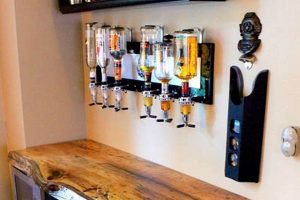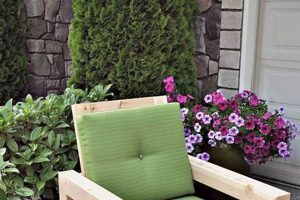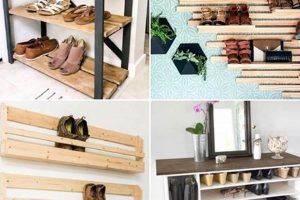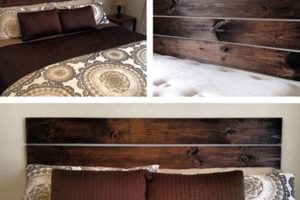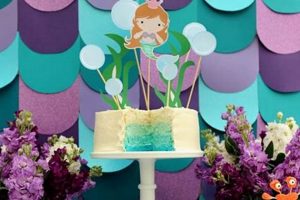The concept encompasses creative concepts and methodologies for personally crafting adornments for the ear. These projects utilize readily available materials and basic techniques, empowering individuals to produce custom jewelry pieces within their own homes. As an example, repurposing old beads, wires, and clasps, or even unconventional items like paper or fabric, can result in unique, handcrafted ear decorations.
This form of crafting fosters resourcefulness and self-expression, allowing for the creation of personalized accessories that reflect individual style and preferences. The activity offers a cost-effective alternative to purchasing mass-produced jewelry and can serve as a fulfilling hobby or even a source of income through the sale of handcrafted items. Historically, creating personal adornments has been a widespread practice across cultures, reflecting ingenuity and artistic flair.
The subsequent sections will explore various design possibilities, material options, and step-by-step construction guides to facilitate the realization of personalized jewelry projects.
Crafting Personalized Ear Ornaments
The creation of custom ear ornaments requires meticulous planning and execution to achieve aesthetically pleasing and durable results. The following advice serves as a practical guide to assist in the process.
Tip 1: Material Selection. Employ materials appropriate for skin contact to minimize allergic reactions. Hypoallergenic metals like sterling silver or surgical steel are recommended for earring posts and findings.
Tip 2: Design Prototyping. Before committing to final materials, create a mock-up of the intended design using inexpensive or scrap components. This allows for adjustments in size, shape, and balance.
Tip 3: Secure Fastenings. Ensure all connecting elements, such as jump rings and clasps, are securely closed to prevent detachment and loss of the ornament. Pliers specifically designed for jewelry making are necessary.
Tip 4: Weight Distribution. Consider the overall weight of the finished product. Overly heavy ear ornaments can cause discomfort and potential stretching of the earlobe. Distribute weight evenly across the design.
Tip 5: Symmetry and Consistency. When crafting pairs, maintain symmetry and consistency in size, shape, and embellishment. Utilize measuring tools and templates to ensure uniformity.
Tip 6: Edge Finishing. Smooth all edges and points to prevent scratching or irritation. Sanding and polishing techniques are vital for achieving a professional finish.
Tip 7: Storage Considerations. Store completed jewelry pieces in a dry environment, ideally in individual compartments or pouches, to prevent tarnishing and entanglement.
Adherence to these guidelines will enhance the quality, longevity, and wearability of handcrafted ear ornaments, leading to a more satisfying crafting experience.
The subsequent section will delve into specific project tutorials, offering step-by-step instructions for creating diverse styles of ear adornments.
1. Material Versatility
Material versatility constitutes a cornerstone of successful endeavors in crafting custom ear ornaments. The range of materials employed directly affects the aesthetic possibilities and structural integrity of the finished product. The wider the array of materials at a crafter’s disposal, the greater the potential for unique designs and personalized expression. For example, employing solely metallic components limits design possibilities compared to integrating textiles, beads, and repurposed materials.
The selection of materials also impacts durability and wearability. Certain materials may be more prone to breakage, tarnishing, or causing allergic reactions than others. Practical application involves understanding the properties of different materials and selecting them accordingly. For instance, using lightweight polymer clay allows for creating large, visually striking designs without causing discomfort, while incorporating resin can provide a protective coating and enhance the ornament’s longevity. Furthermore, the ability to mix and match materials, such as combining metal findings with natural elements like wood or stone, unlocks a diverse array of design aesthetics.
A comprehensive understanding of material properties and sourcing options is vital for individuals seeking to create personalized ear decorations. A broad material palette expands design possibilities, enhances durability, and allows for personalized touches. The ability to adapt designs based on material availability and characteristics is a crucial skill in handcrafted jewelry creation.
2. Design Innovation
Design innovation serves as a central tenet in the domain of personalized ear ornament creation. It directly impacts the uniqueness and aesthetic appeal of individually crafted pieces. Without an emphasis on original or unconventional designs, projects risk replicating commercially available products, thereby diminishing the value proposition of the activity. A commitment to design innovation necessitates exploration beyond established norms and a willingness to experiment with novel forms, material combinations, and construction techniques. As an example, utilizing biomimicry to inspire earring shapes based on natural structures, or incorporating upcycled electronic components into jewelry designs, demonstrates this principle. The application of design innovation transforms basic crafting into an exercise in artistic expression.
The effects of design innovation extend beyond mere aesthetics. Innovative design can address functional considerations, such as improving earring closure mechanisms, reducing weight, or enhancing comfort. Furthermore, embracing sustainable design principles by using recycled or ethically sourced materials represents a form of design innovation with social and environmental implications. For instance, creating earrings from discarded plastic bottles or utilizing fair-trade beads contributes to a more responsible approach to jewelry making. The practical significance of this understanding lies in its capacity to elevate handcrafted ear adornments from simple accessories to statements of personal style and ethical values.
In summary, design innovation is not merely a desirable attribute but an essential ingredient in the creation of personalized ear ornaments. It provides the impetus for uniqueness, addresses functional challenges, and enables the incorporation of ethical considerations. Overcoming the challenge of creative stagnation requires continuous learning, experimentation, and a willingness to draw inspiration from diverse sources. A focus on design innovation strengthens the appeal and value of handcrafted jewelry, linking it to broader trends in art, sustainability, and personal expression.
3. Technique Proficiency
Technique proficiency plays a vital role in the successful realization of handcrafted ear ornaments. The level of skill directly influences the quality, durability, and aesthetic appeal of finished jewelry pieces. Mastery of fundamental techniques is essential for executing increasingly complex and innovative designs. Inadequately applied techniques can result in structural weaknesses, visual imperfections, and ultimately, a diminished final product.
- Wire Wrapping Precision
Precise wire wrapping is crucial for securing beads, creating intricate patterns, and forming durable connections within earring designs. Consistent tension and neat wrapping enhance both the aesthetic appeal and structural integrity of the piece. For instance, poorly executed wire wrapping can lead to loose beads, unraveling, and ultimately, a compromised earring.
- Soldering and Metal Joining
Soldering techniques are necessary for creating permanent joins in metal components, enabling the construction of complex earring structures. Proper soldering ensures that joins are strong, clean, and visually appealing. In contrast, insufficient soldering can result in weak bonds that are prone to breakage, diminishing the earring’s longevity.
- Beading and Stringing Methods
Effective beading and stringing techniques are essential for creating beaded earring designs that are both secure and visually balanced. Correct stringing methods prevent thread breakage, while precise bead placement ensures a cohesive and aesthetically pleasing arrangement. The use of appropriate knotting techniques is imperative for secure closures and to prevent bead slippage.
- Resin Application and Finishing
Resin application can enhance the durability and aesthetic appeal of certain earring designs. Proper application techniques ensure a smooth, bubble-free finish that protects underlying materials and adds a professional polish. Conversely, improper resin application can result in uneven surfaces, air bubbles, and a compromised final appearance.
The integration of these techniques ensures that “earring ideas diy” projects result in durable, aesthetically pleasing, and professionally crafted jewelry. Development of these skills necessitates consistent practice and a keen eye for detail, but the investment yields high-quality, personalized adornments.
4. Component Sourcing
Component sourcing exerts a significant influence over the feasibility, cost, and aesthetic outcome of projects centered on the creation of personalized ear ornaments. The availability and quality of materials directly impact design possibilities and the overall integrity of finished pieces. Inadequate sourcing strategies can constrain creativity, increase production costs, and compromise the durability of handcrafted jewelry. For instance, limited access to hypoallergenic metals may preclude the creation of earrings suitable for individuals with sensitive skin, while reliance on low-quality beads can diminish the visual appeal and longevity of a beaded design.
Effective component sourcing involves identifying reliable suppliers, evaluating material quality, and considering budgetary constraints. Crafters can choose from a range of sources, including online marketplaces, specialized jewelry supply stores, and repurposed materials. Each sourcing option presents unique advantages and disadvantages. Online marketplaces offer a vast selection and competitive pricing but require careful vetting of suppliers to ensure quality. Jewelry supply stores provide hands-on access to materials but may be more expensive. Repurposing materials, such as transforming vintage buttons into earrings, offers a cost-effective and environmentally conscious approach, albeit with limitations on material consistency. Strategic decisions regarding sourcing enable resourcefulness and individualized project scope.
Ultimately, the capacity to source appropriate components efficiently and effectively is crucial for realizing desired designs and achieving satisfactory results in creating personalized ear ornaments. Navigating the complexities of component sourcing, balancing cost considerations with quality expectations, and exploring diverse sourcing options enable practitioners to produce handcrafted jewelry that reflects both individual creativity and practical competence. Challenges such as fluctuating material costs and supply chain disruptions necessitate adaptability and proactive management of component procurement strategies.
5. Durability Emphasis
Durability constitutes a critical factor in the success of any project involving the creation of personalized ear ornaments. The long-term wearability and aesthetic appeal of handcrafted jewelry are directly contingent upon the materials selected and the construction techniques employed. A focus on durability ensures that these handcrafted items withstand the rigors of daily wear and maintain their integrity over time, thereby increasing their perceived value and utility.
- Material Selection for Longevity
The selection of materials with inherent durability properties is paramount. Utilizing robust metals such as sterling silver or surgical steel for earring posts and findings minimizes the risk of bending, breaking, or tarnishing. Incorporating strong, abrasion-resistant beads and stones prevents scratching and chipping. An example of this involves opting for glass beads over plastic alternatives to withstand scratching and breakage.
- Secure Fastening Techniques
The methods used to fasten components together directly impact the overall durability of the ornament. Employing strong adhesives, robust jump rings, and secure crimping techniques ensures that components remain connected under stress. Neglecting secure fastening can lead to component detachment and loss of the ornament’s integrity. This emphasizes the necessity of using heavy-duty pliers and quality adhesives.
- Protective Coating Applications
The application of protective coatings can significantly enhance the durability of handcrafted jewelry. Applying clear resin or varnish to finished pieces shields them from moisture, scratches, and UV damage. These coatings provide a barrier against environmental factors that can accelerate degradation. For example, applying a sealant to clay earrings would drastically improve water resistance.
- Reinforcement Strategies
Implementing reinforcement strategies during construction can significantly enhance the longevity of personalized ear ornaments. Adding extra layers of support to fragile components, such as delicate wirework or thin metal elements, minimizes the risk of breakage under stress. This could involve using a thicker gauge wire or adding an extra layer of resin to sensitive areas.
The multifaceted emphasis on durability translates directly into increased customer satisfaction and enhanced perceived value for handcrafted ear ornaments. Prioritizing material selection, secure fastening, protective coatings, and reinforcement strategies ensures that personalized creations withstand the test of time, representing a worthwhi
le investment for both the creator and the wearer. Addressing challenges associated with material degradation and structural weakness is essential for maintaining the quality and longevity of handcrafted jewelry.
6. Wearability Assessment
Wearability assessment constitutes an integral phase in the conceptualization and execution of handcrafted ear ornaments. It necessitates a thorough evaluation of design parameters to ensure both comfort and safety during prolonged use. Neglecting this assessment can lead to discomfort, skin irritation, or even physical injury, undermining the value and practicality of the handcrafted product.
- Weight Distribution and Earlobe Strain
The distribution of weight is crucial in minimizing earlobe strain. Overly heavy ear ornaments can cause stretching and discomfort, particularly when worn for extended periods. Designs should strategically distribute weight to avoid concentrated pressure on a single point. An example includes using lightweight materials like polymer clay or strategically placing heavier components closer to the ear post to distribute the load more evenly. The impact of inappropriate weight distribution includes possible tears and stretching of piercing.
- Material Compatibility and Allergen Sensitivity
Material compatibility with skin is vital to prevent allergic reactions. Individuals exhibit varying sensitivities to different metals and other materials commonly used in jewelry making. Hypoallergenic materials, such as surgical steel, titanium, and niobium, should be prioritized for components that come into direct contact with the skin. The implication of choosing non-compatible material involves skin irritation, inflammation, and long-term health issues, such as eczema.
- Sharp Edges and Protrusions
The presence of sharp edges or protrusions can lead to skin abrasions and discomfort during wear. Designs should be carefully assessed to identify and eliminate any potential sources of irritation. This may involve smoothing rough edges, rounding sharp corners, or strategically positioning elements to prevent contact with the skin. Failure to address these design elements results in discomfort and potential skin damage.
- Closure Security and Loss Prevention
The security of earring closures is paramount to prevent accidental loss. Closures should be designed to remain securely fastened during normal activity. Regular testing of closure mechanisms is recommended to ensure reliability. Unreliable closures pose a financial burden and cause distress to the wearer. Therefore, the assessment of closure security directly relates to the overall wearability and practicality of the ear ornament.
In conclusion, wearability assessment is an essential component of the creative process. The implementation of practical design features directly influence the customer experience by prioritizing comfort, safety, and security of personalized pieces. The assessment, therefore, needs to be considered to guarantee the long-term use and appreciation of handcrafted items.
Frequently Asked Questions
The subsequent section addresses common inquiries and misconceptions surrounding the crafting of personalized ear ornaments.
Question 1: What are the essential tools required for crafting custom ear ornaments?
The creation of custom ear ornaments necessitates a selection of specialized tools. Essential implements include jewelry pliers (flat-nose, round-nose, and chain-nose), wire cutters, beading needles, and a ruler or measuring tape. Depending on the complexity of the design, additional tools such as soldering irons, polishing cloths, and rotary tools may be required.
Question 2: How can skin irritation be minimized when creating custom ear ornaments?
Skin irritation can be minimized through careful material selection. Hypoallergenic metals, such as surgical steel, titanium, and niobium, are recommended for components that come into direct contact with the skin. Thorough cleaning of tools and materials before use is also essential to prevent the introduction of irritants. Coating non-hypoallergenic materials with clear nail polish can also act as a temporary barrier.
Question 3: What are the most common mistakes to avoid when crafting ear ornaments?
Common mistakes include using insufficient adhesive, failing to properly close jump rings, and neglecting to smooth sharp edges. Overly heavy ear ornaments and unbalanced designs should also be avoided. It is crucial to double-check all connections and closures before wearing the finished product.
Question 4: How can the durability of handcrafted ear ornaments be enhanced?
The durability of handcrafted ear ornaments can be enhanced through the use of robust materials, secure fastening techniques, and protective coatings. Employing strong adhesives, high-quality wire, and durable beads is recommended. Applying a clear sealant or resin coating can protect the ornament from moisture and abrasion.
Question 5: What are the key considerations for designing balanced and aesthetically pleasing ear ornaments?
Key design considerations include symmetry, proportion, and color harmony. Maintaining a balance between the size and weight of different components is crucial. Employing color theory principles can enhance the visual appeal of the design. Prototyping designs using inexpensive materials is recommended before committing to final materials.
Question 6: How can upcycled materials be effectively incorporated into ear ornament designs?
Upcycled materials can be effectively incorporated into ear ornament designs by carefully cleaning and preparing them before use. Repurposing vintage buttons, beads, and fabric scraps can add a unique and eco-friendly touch. However, it is essential to ensure that upcycled materials are durable and safe for skin contact.
By addressing these common questions and misconceptions, individuals can approach the crafting of personalized ear ornaments with increased confidence and skill.
The subsequent section will provide insights into advanced techniques and design trends in the field of handcrafted jewelry.
Conclusion
The preceding exploration of “earring ideas diy” has underscored the multifaceted nature of this creative endeavor. From the selection of suitable materials to the mastery of intricate construction techniques and the implementation of thoughtful design principles, the process demands both artistic vision and practical expertise. This detailed examination has revealed the critical importance of durability, wearability, and aesthetic considerations in the successful creation of personalized ear ornaments.
The pursuit of handcrafted jewelry offers a potent means of self-expression and creative fulfillment. Continued exploration and refinement of these skills will undoubtedly contribute to the advancement of this unique art form, allowing practitioners to produce increasingly sophisticated and meaningful adornments that reflect individual style and ingenuity.


